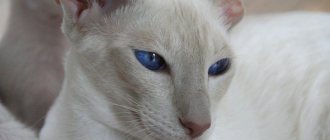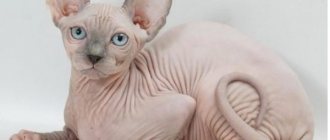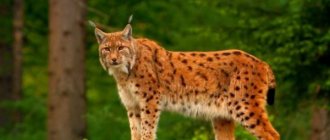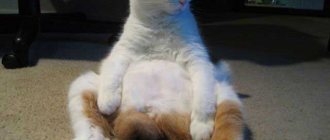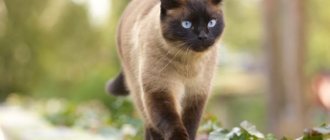History of Pied Pipers
The domestication of cats occurred in Egypt approximately 9 thousand years BC. e. In those days, the grain harvested from the fields was eaten by mice and rats. People saw how cats hunted them and began to lure and tame the nimble hunters. Since then, these animals have taken their place next to people, ridding them of rodents. For such merits, cats were called sacred animals, protecting food supplies and saving people from hunger. Since ancient times, cats have been given special honors, and high fines were imposed for killing them. The cost of a clever rat-catcher cat was equal to the cost of an ox.
Agile rat-catching cats in the old days were worth as much as an ox
There is a legend that says that during the global flood, rodents appeared on Noah’s Ark, dangerous to the inhabitants. Then cats were born from the lions, destroying all the rodents and saving the animals on the ship from them.
Cats conscientiously performed their duties in peasant homes, in monasteries, and at the royal court. Peter I ordered the adoption of cats to protect barns from the invasion of mice and rats. By order of Elizabeth, his daughter, 30 rat-catcher cats were brought to the Winter Palace from Kazan, the city where the most dexterous rat-catchers were believed to live. During the reign of Catherine II, cats appeared in the Hermitage to protect works of art from rodents.
During the siege of Leningrad, cats saved residents and the city itself 2 times. When, in the first years of the siege, all the animals were eaten due to hunger, many rodents appeared in the city, and the Winter Palace was simply swarming with them. To combat dangerous rodents, 5 thousand smoky cats were brought from Yaroslavl to Leningrad in April 1943, then a train of Siberian cats arrived, and soon rodents disappeared from the city.
The Siberian cat is an obstinate hunter
Nothing is known exactly about the origin of this breed; most likely, it was brought to Russia from Asia. She was nicknamed “Siberian” for her traditional long and fluffy fur. The cat, as you see in the photo, stands out for its strong build (females grow up to 5-7 kg, and males up to 9 kg) and powerful strong paws with excellent grip. In addition, the hind legs are slightly longer, which allows them to jump and run well.
The Siberian beauty has an obstinate character, excellent speed and reaction, which makes her an excellent hunter. Looking at her, you immediately understand that the cat has more than once participated in skirmishes with rodents. The animal is not very attached to humans, walks on its own and values freedom. By the way, to keep fit, your cat needs regular walks in the fresh air.
The only thing known about the origin of the breed is that it was brought from Asia to Russia. The breed got its name due to its fluffy and long coat. Some owners get these animals just for their attractive appearance. However, not everyone knows that this breed is a born rat catcher.
The appearance is characteristic: representatives of the breed have a strong body (the weight of males reaches 9 kg, and females - 7 kg) and strong legs with a strong grip. The hind legs of these animals are longer than the front ones, due to which they are able to develop greater speed in running and also jump well. Siberian cats have excellent reactions. Even from their glance it is clear that they are able to take part in the fight against mice and rats.
The character of these animals is quite obstinate. They do not become very attached to their owner, preferring to walk on their own. Their freedom is very important to these animals. Due to its free-spirited nature, such a cat needs periodic walks outside.
What kind of rat exterminator is he?
The Pied Piper is not a cat breed, as many people think, but a rare and valuable quality. Most often it occurs in outbred yard cats. Not spoiled by their owners, adapted to harsh street conditions, they walk wherever they want and retain a keen hunting instinct.
Experts in the meowing family name 5 signs by which you can recognize a future rat catcher in a kitten:
- family tradition: if the cub has a mother and father (or one parent) who are rat catchers, by the age of 4 months they will pass on hunting skills to him;
- belonging to the female sex: cats are naturally more active and bolder than cats (this is due to maternal readiness to protect offspring and to the ancient hunting ritual of cats, obliging the female to attack the victim (the male joins if the prey is large and “male help” is required);
- zeal in play: if a kitten grabs an impromptu mouse - a bow or a toy - with its teeth, and not with its paw, it should grow into a rat-catcher cat;
- tricolor coat: popular rumor calls this feature a marker of a born hunter (geneticists do not comment on this observation);
- morphological features: muscular body, strong legs, powerful jaws, large ears with sharp tips.
The listed signs are only a natural given. Whether it will be implemented depends on the conditions of keeping and raising the four-legged purr. However, amateurish advice “not to feed” can lead to an unexpected result: the unfortunate pet will begin to hunt for the trash can and hang around in garbage dumps.
General features of rat catchers
The rat catcher is not a separate breed of cat, it is the valuable quality of the animal, the sharpness of its hunting instinct. According to felinologists (specialists in breeding cats), rat-catching cats can be identified by the following characteristics:
- muscular body, powerful jaws, strong legs;
- head shape - there is a relationship between the genes responsible for the instincts of hunters and the genes that determine the configuration of the skull of cats: rat-catching abilities are observed in animals with a triangular head (oriental type of cats);
- lush mustache and high ears with tassels at the ends: they allow animals to detect possible rustles, and this is very important for a successful hunt.
Ratcatcher cats usually have large ears that can detect the smallest noises.
Some rat hunters may be affectionate in nature, while others may be unsociable. There are animals that want to please their owner and often catch rats to show him their love. And there are cats that avoid people and do not welcome affection, but this is also quite normal.
Raising a rat catcher and caring for a hunter
In order for a kitten of even a “suitable” breed to grow into an excellent rat catcher, it is necessary to raise it correctly. First of all, it is important that the mother cat hunts rats herself - otherwise the baby will not have the necessary skill, and developing it may be problematic.
The best way to look for a rat-catcher kitten with the “right” skills is through an advertisement or through friends - ask for a kitten from a pregnant cat. With proper upbringing, kittens born by rat-catching cats are almost 100% likely to grow into excellent hunters!
So, when taking on the education of a future hunter, the owner must remember several rules:
- The hunting instinct in a kitten can and should be encouraged - if the pet catches mice, do not forget to praise and reward it.
- There is no need to starve a cat - it will either run away from a careless owner, or begin to beg for food from neighbors or look for it in trash heaps, rather than decide to feast on a rat.
- To prevent your cat from getting fat and lazy, you don’t need to leave food in the bowl all the time - it’s better to feed it in small portions 5-6 times a day.
- The rat catcher must be vaccinated. The most important thing is the rabies vaccination. If a rat has bitten a cat, do not hesitate to visit the veterinarian!
However, it is problematic for a person to raise a hunter kitten on his own, so rat catchers should not be taken away from the mother cat too early, because otherwise she will not be able to teach him all the intricacies of the cat’s “craft.” The optimal age of a kitten is 4-5 months.
© shutterstock
Breeds of rat-catching cats
There are certain breeds in the cat family, whose representatives are distinguished by excellent health, special dexterity and dexterity in catching rats.
Siberian cat
The cat was named Siberian due to its fluffy long hair. She is unpretentious, has a strong build, the weight of cats reaches 7 kg, cats weigh about 9 kg. She has strong paws and excellent grip. Due to the slightly longer hind legs compared to the front legs, the cat has the ability to run and jump quickly. Such animals are obstinate in nature, they have an excellent reaction, which is necessary when catching rats. They are independent and love freedom.
The Siberian cat has a strong build and excellent grip.
To maintain the desired shape, Siberian cats require regular walks in the fresh air.
Maine Coon
Cats of this breed are distinguished by mobility and strength. Maine Coons are hardy and able to live in regions with harsh climatic conditions. These large animals (males can weigh up to 15 kg) have the nature of a predator; they do not welcome human affection. Due to their size, they can easily deal with rats.
Maine Coons easily deal with rats
This breed of cat is distinguished by straight-set large ears, which have tassels at the ends. Maine Coons have long and thick fur. They have well-developed muscles, a wide chest, strong bones, and a thick and long tail. All this data allows Maine Coons to become a real threat to rodents.
Kurilian Bobtail
A feature of animals of this breed is a short tail, the length of which does not exceed 3–8 cm. But they have strong hind legs, which are longer than the forelimbs. And therefore the Kurilian bobtail runs well, jumps, and deftly strangles rats. Males of this breed weigh about 10 kg, females - 6 kg.
The Kurilian Bobtail is fearless and deftly strangles rats
Such cats are capable of completely destroying a mouse or rat hole. They are easy to train and can be trained. People keep them as companions; they get along easily with other animals. Bobtails have a fearless character.
European shorthair cat
Representatives of this breed destroyed rodents back in the days of Ancient Rome. European shorthair cats are called yard cats and are not considered purebred. However, they are popular in the world and are one of the best rat catchers. The predator's passion and agility help them successfully hunt rats and mice.
How to get rid of mice and rats? 8 breeds of rat-catching cats that will find and neutralize rodents
For most of us, cats are the embodiment of home comfort, tranquility and laziness. Few people would think that these charming couch potatoes can bring tangible benefits. And yet it is so. Today we will talk about rat-catching cats that can clean the house and surrounding area from mice and rats
Despite the fact that all cats are predators, not everyone can become a good rat catcher. The rodent hunter must have strong bones, well-developed muscles, long, dexterous paws and (optional) striped or tri-colored coloring that will provide good camouflage.
Gender matters too. Ratcatching cats are very rare; cats usually hunt rodents. They are driven by maternal instinct, or more precisely, by the need to feed and protect their offspring.
If a cat actively catches mice and rats, she will teach her cubs to do the same. Therefore, they should not be separated from their mother earlier than 4-5 months after birth.
Since domestic cats have been living with humans for hundreds of years, they have no urgent need to get their own food. Therefore, in many ornamental varieties, hunting instincts have been lost. On the other hand, there are many breeds that were and remain excellent predators and in which the hunter gene is highly developed.
European shorthair cat
Small smooth-haired animals of gray striped, spotted or marbled color are considered to be outbred. But these “plebeians” caught rats and mice back in Ancient Rome. The European Shorthair cat is a strong, agile and intelligent animal. She loves and knows how to hunt, and at the same time has good contact with people. However, if you pick up a mongrel kitten on the street, you shouldn’t hope that it will start exterminating rats left and right. As a rule, private breeders or nurseries are engaged in breeding really high-quality rat-catcher cats, and often there is a queue for offspring almost a year in advance. If you want such a cat, look for trusted breeders with recommendations, but remember that it takes 4-5 months for a mother to teach her cub predator skills, so you should give preference to older kittens.
Ratcatcher cats can catch rats, mice, snakes and moles equally well, but they will also calmly deal with domestic animals - ducklings or chickens. Therefore, it is important to raise the animal correctly from the very beginning.
Siamese cat
Another hunting breed with a long history. The first mentions of blue-eyed beauties date back to the 13th century. They come from the kingdom of Siam. Smooth-haired, lean animals are distinguished by excellent reactions and the ability to show aggression when necessary. Siamese get along well with people, but have a rather independent disposition. Their small size does not allow these cats to hunt rats effectively, but they do an excellent job with mice. The instinct is transmitted at the genetic level and strengthened in kittens by their mother.
The rat is a fairly large rodent, and therefore the hunter should not be small. It is necessary that she has well-developed muscles, skeleton and jaws, and a stable psyche. If she hides or runs away from any loud sound, the cat will no longer be able to become a good rat catcher.
Maine Coon
These luxurious, large (weighing up to 15 kg) cats come from America, more precisely the state of Maine. They were specially bred to exterminate mice and rats on farms and ships. Despite their impressive size, Maine Coons are agile and agile. Large ears provide them with excellent hearing, and strong paws provide them with a good grip.
Thick, long hair allows the Maine Coon to live in harsh climates. But it also creates problems for the owners. The fact is that these cats need to be brushed regularly. If you leave the animal to its own devices, the magnificent fur will quickly become tangled and no longer protect against the cold.
The disadvantages of Maine Coons include gluttony (which should not be surprising, given their size) and independent character. These natural hunters are not particularly interested in constant human contact. They shy away from petting that they consider inappropriate, and if the owner is too intrusive, they can get angry and bite.
Ratcatcher cats need regular, long walks to stay in good physical shape.
Russian blue cat
This is a real aristocrat among rat catchers. Russian blue cats were kept at court by many royals, for example, Peter I and Catherine II. Centuries later, these graceful, smooth-haired animals remain excellent hunters. They can handle not only mice, but also rats weighing up to 0.5 kg!
It is worth noting that Russian Blue cats do not get along well with representatives of other breeds, but get along well with their own. Like many other predators, they are not particularly susceptible to affection, but at the same time they treat people with sympathy and rarely show aggression.
Please note - a lazy, barely mobile cat cannot become a good rat catcher.
Kurilian Bobtail
Bobtails are quite large animals, capable of rivaling Maine Coons in size. The weight of a cat can reach 10 kg, and that of a cat - 6 kg. The homeland of this breed is the Kuril Islands. Difficult living conditions raised them to be brave and strong hunters. They have a short tail and strong legs, providing excellent jumping ability. Bobtails cope with both mice and large rats.
Among other breeds, the bobtail is distinguished by its sociability and easy-going character. They readily make contact with humans, are easy to train and get along well with other animals, including large dogs. This makes them similar to another “tailless” cat - the Manx cat
, which also has a friendly disposition combined with excellent hunting skills.
Kurilian Bobtail
Manx cat
Cymric
These are medium-sized cats, also without a tail. They have long, tenacious legs that allow them to catch up with prey and grab it with a death grip. They have a strong skeleton with athletically developed muscles. Cymrics are sociable and active, and it is very important for them to spend a lot of time outdoors. It is not worth keeping such a mobile animal in an apartment - during games it will destroy everything around. Experienced breeders recommend keeping these cats in country houses.
Siberian cat
Siberian cat
This breed appeared in Siberia several centuries ago. Harsh winters forced these large cats, weighing up to 9 kg, to grow thick, long hair and learn to get enough food for themselves to survive. The Siberian cat is an excellent hunter, killing both mice and rats. She easily and quickly overtakes her prey, and her long claws do not allow her to escape. Cats are patient and can stalk their prey for hours, waiting for the best moment. The animal loves to spend time outdoors, so it is better in the house than in the apartment. It is not aggressive, but it treats people rather indifferently. Siberian is a cat that walks on its own.
British shorthair cat
British cats combine developed hunting instincts, friendliness and calmness. The weight of the animal rarely exceeds 4 kg, so it is difficult for it to fight with a rat. But the British do an excellent job with mice. And they often bring them home as a gift to the owner. You shouldn’t be angry about this, because this is how the cat shows care. From her point of view, a person is a helpless creature, unable to provide food for himself.
Of course, choosing a kitten from this list does not mean that an excellent rat catcher will appear in the house. Heredity is of great importance. Let's repeat - if a mother cat is a good hunter, most likely her kittens will be the same. A clue as to whether a kitten will catch mice and rats can be its behavior. If during play he grabs the “prey” with his teeth, and not just grabs it with his paws, most likely he has a tendency to hunt.
You need to play active games with the growing animal, let it go for walks around the area as often as possible and reward it for every prey, even if it is not a mouse or rat, but an insect. At the same time, it is impossible to starve an animal by pushing it to obtain food on its own. The cat will look for food, scouring garbage dumps, or even leave altogether in search of a better life. You need to feed the rat catcher 4-6 times a day, in small portions.
It is extremely important to regularly give your cat all necessary vaccinations, and first of all - against rabies. After all, during a hunt, a pet can pick up a dangerous infection from a rodent. And of course, if traces of scratches or bites are found on your pet’s body, you should immediately contact a veterinarian
What cats catch mice and rats
Many owners living in the private sector are specifically looking for mousecatchers. However, identifying them is not always easy. Some rely on genetics. In other words, if the mother was a mousetrap cat, then the kitten will inherit her gift. Another option is breed.
Mousecats are especially needed in private homes
There is no doubt that certain members of the cat family have a greater propensity for catching rats or mice. However, there are other ways to determine which cats are better at catching rats and mice.
How to identify a rat-catcher cat
The first thing you should pay attention to is the color of the animal. Representatives with gray, black, brown, or red skin blend better with nature and, as a result, are more successful hunters. White, unfortunately, in this case, is the most losing.
The second point is education. It is very important how the kitten behaved in childhood. Outdoor games with a bow, a ball, chasing the light of a laser pointer - all this is the preparation and development of hunting instincts.
For your information! Yard cats and female cats are excellent mousecatchers. The point is also that they develop their instincts from childhood. Hunting for them is a way to survive.
An equally interesting question is whether the rat-catcher cat will continue to hunt after castration. The animal's behavior changes after this operation, but this does not mean that it will lose its innate and developed instincts. The only thing you should be careful of in this situation is overfeeding your pet. Such measures often lead to obesity, and, as a result, hunting skills decrease. Therefore, a neutered cat should be given a special diet, so that he will continue to perform the task assigned to him.
Who is better at catching: a cat or a cat?
Jungle cat: options for breed names and animal sizes
The question of who is better at catching mice and rats, a cat or a cat, also often worries owners who are planning to take an animal into the house. You might think that females are better hunters due to their developed maternal instinct. Indeed, a girl must provide food not only for herself, but also for her kittens. In addition, the cat’s genetics is less about hunting and more about procreation. The male must find and fertilize the female, so the hunter's instinct is slightly less developed in him.
Important! If a rat-catcher cat appears in the house, owners should take one point into account. Felines can deal not only with pests (moles, mice, rats, snakes), but also with some poultry, such as ducklings and chickens. In this case, the animal should be raised correctly.
Masking color
How to choose the right cat
Oddly enough, non-pedigreed animals that have lived on the street for some time are best suited for the role of a rat trap. The experience they gain brings invaluable benefits in hunting rodents. Such cats know how to get their own food, have the proper “fighting” skills and hardening. Catching rats is one of the basic components in their survival. This refers to animals that were born and raised on the street, and not those that ended up there after a long life in the house.
If you do not want to adopt a cat from the street, then it is worth remembering that a “rat trap” is not a specific breed. If desired, almost any cat can be raised to become a rodent hunter. Still, there are cat breeds that cope with this role better than others. These include:
- Maine Coon;
- Siberian cat;
- Cymric;
- Kurilian Bobtail;
- Siamese cat;
- European;
- Siberian;
- Russian Blue;
- British Shorthair.
Time has shown that these are the breeds that hunt pests most effectively. When choosing the right cat, you should also pay attention to a number of the following factors.
The animal's build must be large. When hunting, a cat will need developed muscles and physical strength. Low stature is another important point. It will allow the rat trap to be more compact and agile.
Another sign of an excellent rodent hunter is the triangular structure of the skull. To more accurately determine the shape of the skull, simply press the animal’s ears to its head. When choosing a rat-catcher cat, it is better to give preference to the triangular structure of the skull.
It has been proven that the hunting skills of females are superior to those of cats. This is due to the cat’s lifestyle: she needs to protect her offspring, feed them and teach them how to get food. This is why you should choose a cat if you want to achieve maximum efficiency.
If you are going to raise a ratcatcher from a kitten, pay attention to how she plays with a toy mouse. Real hunters try to use their teeth and gnaw their prey rather than roll it with their paws.
Benefits of cats
So, a rat-catcher cat is necessary if there are rats in the house. These unpleasant creatures can spoil food, property, and carry dangerous diseases. If almost every cat can cope with mice, then not everyone can “go into battle” with a large, large and dangerous rat, especially because an old seasoned rat is often the size of a cat itself. To cope with it, you need a special character, skills and preferences, so you need to choose such a cat carefully, making the right choice. It is important to understand that such a pet will most likely occasionally be injured by rats - rodents can injure the face, tail, paws, etc.
Another reason for choosing a cat as a solution to the “rat” problem is the developing, flexible, lively mind of rats, which can avoid poison traps and mousetraps. Cats are capable of destroying the “enemy” once and for all, so that soon there will be no rats left in the house.
For the first time, brave rat catchers began to be used en masse in Leningrad, when mice and rats destroyed food supplies. The cats saved the whole city from the problem in a few weeks.
What breeds of cats can make good rat catchers?
Today, domestic animals rarely hunt rats, since food is abundant and there is no need to protect their offspring. Only some cat breeds still retain a pronounced hunting instinct: they are more suitable for catching rodents. Usually these are so-called native cats - that is, bred naturally, without human intervention. These breeds include:
- Maine Coon. This is a breed that was originally bred to control rodents on farms. These are very calm and good-natured cats who are excellent at catching rats, because in fact they are very passionate hunters. Long hair and a muscular body allow them to withstand both heat and cold, so visiting the street will not be a difficult ordeal for the Maine Coon.
- Kurilian Bobtail. This breed of short-tailed cats is distinguished by the fact that its representatives have a “canine” character, are highly trainable, and protect the property and their owner not only from mice and rats, but even from other people’s dogs.
- Siberian cats. These are powerful, balanced cats, real hunters. They are among all the breeds existing today and are considered the best rat catchers. It is quite possible that Siberians have “wild” blood. This is evidenced by the fact that such cats rarely become very attached to humans - they are cats that walk “on their own.”
- Siamese cats. They are curious and active, and the breed itself was bred without human intervention. These are very fast and graceful animals with a very developed hunter instinct, and therefore neither rats nor mice will have a chance.
- European cat. This is the oldest breed of rat-catcher cat. It is believed that it was common in ancient Rome.
© shutterstock
Despite the presence of cat breeds that are ideally suited for catching rodents, outbred animals that have lived on the street for at least some time cope best with this task: due to the need to get their own food, they have a much more pronounced hunting instinct and excellent skill. This does not apply to cats that were indoors and by chance ended up on the street.
Ratcatcher cats for rent: where to find, cost
Buying a real rat catcher is quite difficult: you can be deceived for a lot of money. However, in some cities it is possible to rent a cat. You should know that ratcatcher cats are available for rent from breeders, many specialized nurseries, and animal and pet supply stores. After the rats are killed, the animal is returned.
For a cat, being in a new place with unfamiliar people can be stressful, so you cannot be sure that in such an environment he will catch rodents.
You can rent a ratcatcher cat
For this purpose, you can find a rat-catcher cat via the Internet, using message boards, for example, the site for finding part-time jobs YouDo, or specialized forums. There is no fixed price for such services; sometimes it is set depending on the cost of the cat itself. Typically, the price of such a service varies from 500 to 3 thousand rubles.
Forum participants generally have a negative attitude towards giving their animal to catch rats, since no one wants to create a stressful environment for the cat, and besides, this can be dangerous: the rats may already be poisoned.
Suitable breeds
Ratcatcher cats, as a rule, belong to indigenous breeds that have undergone minor changes and gene transformation. It was from them that the skills of rat catchers were formed naturally, which gave an impressive result.
Maine Coon
These cats were created and preserved precisely because Maine Coons showed excellent skills in hunting rats. They were kept on farms where rodents pose a problem in the storage of grain and other feed.
Kuril defender
The famous Kurilian Bobtails, despite their rather cute appearance, are excellent rat-catching cats. They are aggressive towards attackers, capable of repelling even the invasion of dogs into the territory they protect, and they deal mercilessly with rodents. Bobtails also love plenty of space to play around. In addition, they are well trained and are not at all afraid of water.
The breeds of cats that are good rat catchers also include the Kurilian Bobtail. The bobtail cat first appeared in Russia in the 20th century, when it was brought from the Kuril Islands. These animals are distinguished by their loyal nature to humans. In some ways they even resemble dogs in character.
Kurilian bobtail kittens immediately become attached to a person and try in every possible way to protect him from all sorts of troubles. The latter include rodents. By the way, in addition to mice and rats, bobtails are capable of driving away small dogs that have encroached on their territory.
The breed is distinguished by a small tail, the maximum size of which is only 8 cm. In body structure, these animals resemble a lynx: they have long and powerful hind limbs, allowing them to make excellent jumps. Kurilian bobtails are capable of running at high speed and crushing mice and rats.
The weight of these animals is up to 6 kg in females and up to 10 kg in males. Whatever the hole is - a mouse or a rat, the Kurilian Bobtail can cope with it; it is not without reason that they are often found on farms and in houses where rodent pests predominate.
There have also been cases of cats predicting earthquakes and gas leaks. The Kurilian Bobtail has the character of a warrior: bold and daring.
The peculiarity of the breed is its short tail, which grows only 3-8 cm in length. In return, the animal has limbs of a special structure: the hind legs are always more powerful and longer than the front ones, thanks to which the “domestic lynx” jumps well, runs quickly and crushes rats with ease. The color of a cat can be very different, with the exception of white, lilac and chocolate shades. Weight reaches 10 kg in males and 6 kg in females. The expert will tell you more about the breed in the next video.
We invite you to familiarize yourself with: Mating of British breed cats: how long they go during pregnancy, childbirth || Rules for breeding cats of the British breed
Bobtails can destroy entire mouse and rat holes, so they are most often kept outside the city, on farms and in other places where there are problems with rodents. These cats are trainable and amenable to training, so they do not cause problems for their owners. Companion cats easily find language with both humans and other pets.
Cat Breeds Suitable for Rat Hunting
There are some active breeds of pussycats. These are native cats. Their hunting instincts are inherited from distant wild ancestors. They are the most suitable for killing rats. Animals of these breeds are unpretentious and adapted to life in a private home.
Aboriginal cats are the best hunters
These include the following types:
- Cymric. This is a representative of non-standard appearance with a short tail. She can hunt for rodents for a long time . Thanks to its long and powerful legs, Kymrik quickly overtakes its prey. Animals are smart and devoted to their owner.
- British Shorthair. These are passionate hunters, tracking their prey for hours. The British have a balanced character. They are ambitious and try to serve their master.
- Maine Coon. Large, large sizes. They have powerful bones, developed muscles, and a wide chest. The weight of the predator reaches 15 kg . These mighty pussies are adorned with large tasseled ears. An animal with such a build easily copes with rats.
- Kurilian Bobtails. Cats have a strong build, a short tail, and their hind legs are longer and more powerful. Thanks to this, bobtails run and jump well . They are brave hunters. Cats with high intelligence are easy to train, loyal and devoted to their owner.
- Siberian. They have a strong build, powerful paws, long hair, and striped color. Weight reaches 7-9 kg . An animal with good reactions, runs fast, jumps well. Cats are freedom-loving, with an obstinate character, and do not become attached to humans.
- The Russian Blue is a natural hunter . She immediately chases the rat and destroys it. Clean, attached to people.
- European Shorthair. They have smooth short hair of gray or silver marbled color, a lean body, and a graceful figure. The animal has a balanced but obstinate character.
Abyssinian cat
Abyssinian cats are the oldest representatives of the domestic cat family. They were depicted in ancient Egypt on frescoes and even made into statues. For a long time, scientists argued that Abyssinian cats formed in Abyssinia (Ethiopia). However, recent research has shown that the breed may have come from Southeast Asia.
Abyssinian cats have a very capricious character. They are curious and demanding, so they are ready to explore every corner where they live. “Abyssinians” will not let anyone near them if they are dissatisfied with something. However, they appreciate affection and love to talk.
Thanks to its large ears, the breed is considered one of the best rat catchers. “Abyssinians” are very energetic and are always ready to spend their reserves of strength. They often direct their activity towards hunting.
Nature or nurture
Cats have long been domesticated by humans. Their natural hunting instinct helps many. When studying the habits of animals, attention was paid to two factors: the ability to catch is influenced by heredity and habitat. More than half a century ago, an experiment was conducted. Four cat families with kittens were selected. Two of them are yard dogs, the others are thoroughbreds.
The mothers had their children (kittens) replaced. As a result, the village animals showed and taught “their” children to hunt. The cats brought in captured rodents every day. In parallel families there was a different picture; there was no need to look for food and kill. Thoroughbred mothers played hunting with little “nobles” without teaching them hunting skills.
If you need to find an excellent rat catcher, you need to pay attention to those kittens who grew up in nature. If it is important to keep an animal not from the street, we recommend choosing a kitten from a nursery. They have a real opportunity to learn everything thanks to free access to the site.
Some selection tips
To help those who want to purchase or raise a pet hunter, here are some recommendations:
- A rat is a large rodent. Accordingly, the cat must have a developed skeleton, muscles, and strong jaws. A lazy animal will not be able to hunt. A cat's body size is based on muscles, not layers of fat.
- When choosing a breed, you need to consider natural (aboriginal) varieties. Artificial selection greatly reduces skills. Those cats that owe their origin to wild ancestors are more ready for hunting. Many consider barn cats to be champions in catching rodents. The strongest individuals survive in the natural struggle for existence.
- Any cat on the street does not have to be a rat catcher. Many of them are former pets, who, by chance or by their owners, live in basements and entrances.
- One way to find a skilled hunter is to take an older kitten from a mother rat catcher. The cat teaches children, they are given abilities coupled with natural instinct. There is no need to adopt kittens when they are small. It takes time to learn and mature.
Important ! If a rat bites you, you need to help your cat. The veterinarian will treat the bite site and give an injection. It is easier to prevent the problem and get your pet vaccinated on time.
Features of care and maintenance
A real rat catcher can be raised from a small kitten. You just need to use some tips:
- To maintain the hunting instinct, the animal should be given food in small portions at least 5-6 times a day. To prevent the cat from becoming lazy, it should not be overfed. Food should not be in the bowl all the time, but the cat should not be left hungry either, since the rat hunter will need strength to attack the rodents.
- It is necessary to cultivate a hunting sense in the future rat catcher, praise and encourage him for any prey he catches: a bird, a mouse, a fly.
- It is difficult for a person to raise a kitten to be a rodent hunter, and therefore there is no need to separate it from its mother cat for up to 5 months so that during this time she can teach him the necessary skills.
- The pet must lead an active lifestyle; it requires not only toys in the form of balls, mice, bows, but also special play complexes.
The gaming complex will help your pet maintain an active lifestyle - Rat catchers need to be vaccinated against rabies to boost their immunity, since rats are aggressive animals. When cats receive wounds from rodents, the damaged areas must be carefully treated and consulted with a veterinarian.
Otherwise, the care and maintenance of rat catchers is no different from the care of ordinary cats.
Catchers of rodents among cat breeds
Rat catchers are not listed in the breed registries of felinological organizations. Everyday experience shows that most often rat-catching cats are found among the following breeds:
- the Kurilian Bobtail is a brave hunter, capable of repelling attacks not only from rats, but also from dogs, an excellent swimmer, and easy to train;
- Russian Blue - a favorite of sailors, a thunderstorm of “super rats” reaching 500 grams, an opponent to bask on the owner’s lap; obstinate towards “stranger partners” (but gets along well with rat-catching cats of her own breed);
- Siberian - an unpretentious and silent virtuoso hunter, distinguished by sharp bladed teeth and huge heavy paws;
- Kimrskaya - a frisky short-tailed beauty, distinguished by a heightened hunting instinct, amazing dexterity, speed of reactions, excellent health;
- the European Shorthair is a faithful defender of barns, ready to pursue prey even in a state of satiety;
- The Maine Coon is the largest rodent catcher, combining strength, agility and beauty.
Read:
Transporting cats in Russia: in a car, train, plane, what you need to prepare
The photos will help you evaluate the “fighting qualities” of rat-catching cats of the named breeds. Furry hunters differ in character and attitude towards their owners - they can be affectionate or unsociable. What unites them is their breeding under natural conditions, and not through artificial selection.
Expressed instinct
Experts say that the hunting instinct is inherent in any cat, regardless of breed and origin. However, the severity of this instinct is not observed in all felines. Breeders believe that the important points here are the upbringing and location of the kitten in the first months of its life. Animals raised in suburban conditions with access to live prey are the best rat-catching cats. Photos of such home earners often appear online with enthusiastic comments. It would seem that he is a lumpy Persian, but he is so smart! Remember: even purebred cats that live outside the city for a long time can learn to catch mice. Choose a cat, not a breed.
Maine Coon
The history of the breed is shrouded in legends and mysteries. It is generally accepted that the first Maine Coons originated in Maine (USA), where aboriginal cats adapted to the climate of the area. Distant relatives of the breed were taken on ships, where the cats caught rodents and saved provisions. Maine Coons escaped extinction only because they had excellent hunting skills. Many farmers gave their preference to them.
American Maine Coons are considered the largest cat breed in the world. They are perfect for the role of a rat-catcher cat. Despite the fact that since the mid-twentieth century they began to be used as companions, the breed still retains its active hunting instinct. Now Maine Coons are the most popular breed in the world.
How to teach your pet to catch mice
If you need an animal to fight mice, you should think about what breed of cat is best at catching mice. You should not buy kittens that are too small. They should receive at least basic lessons in rodent catching from their mothers. If the kitten has not learned anything, the owners will have to work hard. Using special mice-like toys, you can teach a kitten to hunt like this:
- Carry a toy on a string around the room so that the kitten will chase it;
- tie a rope to a stick and use it as a fishing rod;
- Subsequently, replace the toy with a real mouse. Gradually your kitty will learn to hunt.
What cat doesn't catch mice? It is useless to expect a miracle from an adult animal that has never done this. It’s another matter if it used to hunt and then stopped. Feeding your pet a lot of fatty foods or preservatives can cause laziness. The cat becomes heavy and sometimes painful.
To return the animal to its usual activity, it is necessary to change its diet. After several days of balanced food, a live mouse can be given to the cat. A couple more of these trainings, and your pet will remember forgotten skills. When asked which cats are better at catching mice, most cat lovers tend to consider them lazy.
Russian blue cat
The blue cat is a prominent representative of rat-catching cats. This animal does not watch its prey for hours; it, immediately noticing a moving object, rushes after it. Representatives of the blue cat breed have an aristocratic character, they are very affectionate, kind, capable of becoming attached to their owner and following on his heels.
The blue cat is very friendly and loves meeting new people, but at first she is suspicious and wary of new people. She gets along well in the same territory with other animals and gets along well with small children. Representatives of the breed are interested in all new objects that appear in the house or apartment.
How to identify a hunter cat
Not every cat will risk getting involved with a rat because of its impressive size. Therefore, the build of the future hunter must be appropriate: quite large, with a developed, muscular body and a powerful grip with strong jaws. Do not confuse a muscular animal with just a well-fed couch potato. This guy will never catch rats.
For reference:
The best rat-catchers are females.
Their rapid mercilessness aimed at malicious little ones is associated with parental instinct. The rat is an enemy that threatens the offspring and the mother will desperately defend it .
The litter from rat-catching cats sells like hot cakes. After all, hunting instincts are inherited by children, and mothers will personally teach their offspring the art of rat catching. If you want to get a good hunter, do not take the kitten away from its mother before it has learned all the tricks.

